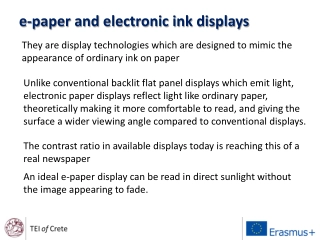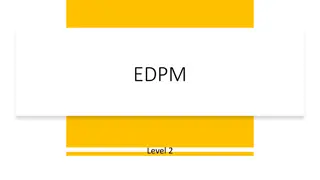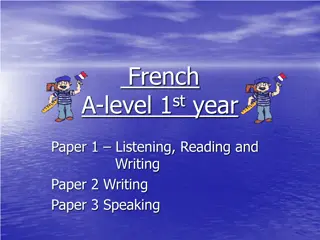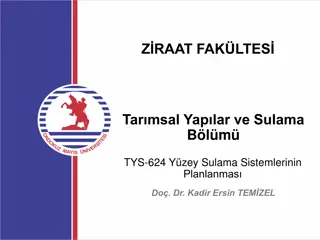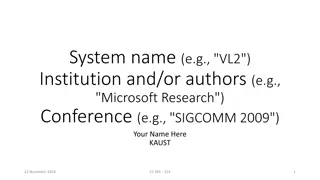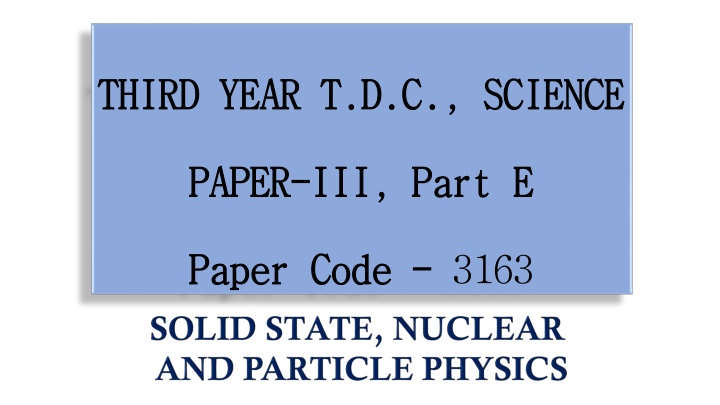
Crystallography and Quantum Mechanics in Electron Behavior
Explore the connection between crystallography and quantum mechanics in understanding electron behavior within materials. Discover how the free electron model and Schrödinger equation play crucial roles in predicting electron movements and properties, ultimately shedding light on fundamental principles in material science.
Download Presentation

Please find below an Image/Link to download the presentation.
The content on the website is provided AS IS for your information and personal use only. It may not be sold, licensed, or shared on other websites without obtaining consent from the author. If you encounter any issues during the download, it is possible that the publisher has removed the file from their server.
You are allowed to download the files provided on this website for personal or commercial use, subject to the condition that they are used lawfully. All files are the property of their respective owners.
The content on the website is provided AS IS for your information and personal use only. It may not be sold, licensed, or shared on other websites without obtaining consent from the author.
E N D
Presentation Transcript
THIRD YEAR T.D.C., THIRD YEAR T.D.C., SCIENCE SCIENCE PAPER PAPER- -III, Part E III, Part E Paper Code Paper Code - - 3163
UNIT 1 : CRYSTALLOGRAPHY BLOCH FUNCTIONS: I. Free Electron Model Before going on to the Bloch Functions, we have to first look at the wave nature of electrons in a crystal. The simplest way to do this is by understanding the wave nature of free electrons in crystals According to the free electron model, the most weakly bound electrons in a constituent atom are able to move freely throughout the material and the ions do not affect it. The total energy therefore is only the kinetic energy and the potential energy can be neglected since it is assumed to be completely uniform and so does not affect (change) the energy of the electron. These electrons, called conduction electrons in metals are responsible for the electrical conductivity in metals. 2
UNIT 1 : CRYSTALLOGRAPHY I. Free Electron Model But even in metals, this model does not explain paramagnetic susceptibility of conduction electrons, heat capacity, occurrence of long electronic free paths etc. To explain these affects, quantum mechanics has to be invoked and the concept of matter waves has to be introduced Lattices have a periodic structure and matter waves propagate freely in a periodic structure In this model, we consider the wave nature of electrons 3
UNIT 1 : CRYSTALLOGRAPHY I. Free Electron Model Using this approach, each electron can be represented by a wave function which is a function of position and time such that * represents the probability of finding the electron at that particular position at that particular time. This wave function is then used in the Schr dinger equation In quantum mechanics, the Schr dinger equation plays the role of Newton s laws of motion and law of conservation of energy in classical mechanics It thus predicts the future outcomes of a dynamic system but unlike in the classical sense, it does so in terms of probabilities of outcomes 4
UNIT 1 : CRYSTALLOGRAPHY I. Free Electron Model : Electrons moving in a One-Dimensional Potential Well For consider an electron within a one- dimensional crystal of length a purposes of simplicity, In the Figure the crystal lies along the X-axis The potential energy everywhere within this crystal is assumed to be constant and equal to zero. This means that in this model we assume that the ions (or nuclei) play no role in deciding the movement of electrons At the two ends of the crystal, a very high potential energy barrier, V0 = , prevents the electron from leaving the crystal. 5
UNIT 1 : CRYSTALLOGRAPHY ------------------ Eq.1 I. Free Electron Model : Electrons moving in a One-Dimensional Potential Well The conditions for the potential V(x) is given by: Thus Schrodinger equation for an electron of mass m becomes : in a crystal, the ------------------- Eq.1 6
UNIT 1 : CRYSTALLOGRAPHY I. Free Electron Model : Electrons moving in a One-Dimensional Potential Well ------------------ Eq.1 A Simple periodic function which will satisfy this equation is: ------------------- Eq.2 ? ? = ?sin?? + ?cos?? A and B are arbitrary constants which can be determined by applying the boundary conditions. Here we are considering an electron which is bound inside a crystal of length a and so the electron wave function has to satisfy two boundary conditions simultaneously 7
UNIT 1 : CRYSTALLOGRAPHY I. Free Electron Model : Electrons moving in a One-Dimensional Potential Well ------------------- Eq.2 ? ? = ?sin?? + ?cos?? The First Boundary Condition is: (i) =0 at x=0 From Equation 2 we see that when x=0, sin (kx) goes to 0, while cos(kx)=1. So this means that for =0 at x=0, the constant B has to be 0 8
UNIT 1 : CRYSTALLOGRAPHY I. Free Electron Model : Electrons moving in a One-Dimensional Potential Well ------------------- Eq.2 ? ? = ?sin?? + ?cos?? The Second Boundary Condition is: (ii) =0 at x=a But we have seen that by the first boundary condition, B is already 0. So this means that ?sin?? = 0 Now A cannot be zero since if both constants are zero, is always equal to zero. 9
UNIT 1 : CRYSTALLOGRAPHY I. Free Electron Model : Electrons moving in a One-Dimensional Potential Well ------------------- Eq.2 ? ? = ?sin?? + ?cos?? This means that sin?? = 0 or ? =?? ? Here, n is an integer number=1, 2, 3 .. n cannot be zero since this again means that =0 everywhere in the box In slide No. 4 we have mentioned that * describes the probability of finding the electron at that particular position at that particular time. So if =0 everywhere in the box (when n=0), this means that the electron is not present 10
UNIT 1 : CRYSTALLOGRAPHY I. Free Electron Model : Electrons moving in a One-Dimensional Potential Well 11
UNIT 1 : CRYSTALLOGRAPHY I. Free Electron Model : Electrons moving in a One-Dimensional Potential Well The solution to the Schrodinger wave equation (Eq. 1) for the region 0 < x < a is : ??= ?sin??? ? ------------------- Eq.3 For each value of n, there is a corresponding quantum state ?? with an energy En In other words, the electron cannot have any value of energy and the energies are quantized. 12
UNIT 1 : CRYSTALLOGRAPHY I. Free Electron Model : Electrons moving in a One-Dimensional Potential Well Expression for En 13
UNIT 1 : CRYSTALLOGRAPHY I. Free Electron Model : Electrons moving in a One-Dimensional Potential Well Expression for En Putting these terms back into (1), we get, Thus we can see that bound electrons can have only discrete values of energy. The lowest energy is when n=1 or, 2 8??2 ?1= and any ??= ?2?1 14
UNIT 1 : CRYSTALLOGRAPHY Bloch Functions and Bloch Theorem The free electron model which we have considered above explains phenomena such as electrical conductivity, thermionic emission etc. which the classical model could not. However, it cannot explain why some materials are good electrical conductors, semiconductors or insulators. In the free electron model, we assumed that the electron is in an infinite square well potential in which the electron sees the same (zero) potential from one boundary to the other. 15
UNIT 1 : CRYSTALLOGRAPHY Bloch Functions and Bloch Theorem In the free electron model, the role of the ions (nuclei) was neglected. But actually the bottom of the well not flat; the nuclei (positive ions actually) create potential wells that are periodic within the box 16
UNIT 1 : CRYSTALLOGRAPHY Bloch Functions and Bloch Theorem The periodic potential V(x) can be defined using the lattice constant a as: V(x) = V(x+a) Using this type of a periodic potential, Bloch showed that the one dimensional solution of the Schrodinger equation is: ? ? = exp ??? ??? ----------------------------------- Eq. (4) In three dimensions, it becomes: ??? = exp ??.? ???--------------------------------- Eq. (5) 17
UNIT 1 : CRYSTALLOGRAPHY Bloch Functions and Bloch Theorem The expressions in Eq.(4) and (5) are the Bloch functions in one and three dimensions respectively. They represent the free electron wave modulated by the periodicity of the lattice through periodic functions ??(?) (for 1 dimension) or ??(?) (for 3 dimensions) 18
UNIT 1 : CRYSTALLOGRAPHY Bloch Theorem Bloch s theorem gives a method to describe the wave function for periodic solids. It places constraints on and therefore also for the values of E for periodic solids Since the solid is periodic at the atomic scale, a traveling wave solution (exp ??.? ) for that is modulated by the translational symmetry of the lattice (??(?)) is obtained So, in the Bloch function given by equation (5), -1a ??? = exp ??.? ??? , ??? = ??? + ? 2b Here, Tis the translational vector which takes us from one lattice point to another (already explained in PPT Unit1A, see figure). 19





